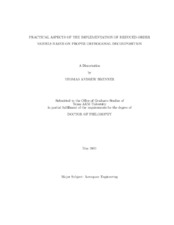| dc.contributor.advisor | Cizmas, Paul | |
| dc.creator | Brenner, Thomas Andrew | |
| dc.date.accessioned | 2012-07-16T15:56:49Z | |
| dc.date.accessioned | 2012-07-16T20:32:21Z | |
| dc.date.available | 2012-07-16T15:56:49Z | |
| dc.date.available | 2012-07-16T20:32:21Z | |
| dc.date.created | 2011-05 | |
| dc.date.issued | 2012-07-16 | |
| dc.date.submitted | May 2011 | |
| dc.identifier.uri | https://hdl.handle.net/1969.1/ETD-TAMU-2011-05-9235 | |
| dc.description.abstract | This work presents a number of the practical aspects of developing reduced-
order models (ROMs) based on proper orthogonal decomposition (POD). ROMS are
derived and implemented for multiphase flow, quasi-2D nozzle flow and 2D inviscid
channel flow. Results are presented verifying the ROMs against existing full-order
models (FOM).
POD is a method for separating snapshots of a flow field that varies in both time
and space into spatial basis functions and time coefficients. The partial differential
equations that govern fluid flow can then be pro jected onto these basis functions,
generating a system of ordinary differential equations where the unknowns are the
time coefficients. This results in the reduction of the number of equations to be solved from hundreds of thousands or more to hundreds or less.
A ROM is implemented for three-dimensional and non-isothermal multiphase
flows. The derivation of the ROM is presented. Results are compared against the
FOM and show that the ROM agrees with the FOM.
While implementing the ROM for multiphase flow, moving discontinuities were
found to be a ma jor challenge when they appeared in the void fraction around gas
bubbles. A point-mode POD approach is proposed and shown to have promise. A
simple test case for moving discontinuities, the first order wave equation, is used to
test an augmentation method for capturing the discontinuity exactly. This approach
is shown to remove the unphysical oscillations that appear around the discontinuityin traditional approaches.
A ROM for quasi-2D inviscid nozzle flow is constructed and the results are com-
pared to a FOM. This ROM is used to test two approaches, POD-Analytical and
POD-Discretized. The stability of each approach is assessed and the results are used
in the implementation of a ROM for the Navier-Stokes equations.
A ROM for a Navier-Stokes solver is derived and implemented using the results
of the nozzle flow case. Results are compared to the FOM for channel flow with a
bump. The computational speed-up of the ROM is discussed.
Two studies are presented with practical aspects of the implementation of POD-
based ROMs. The first shows the effect of the snapshot sampling on the accuracy
of the POD basis functions. The second shows that for multiphase flow, the cross-
coupling between field variables should not be included when computing the POD
basis functions. | en |
| dc.format.mimetype | application/pdf | |
| dc.language.iso | en_US | |
| dc.subject | computational fluid dynamics | en |
| dc.subject | reduced-order modeling | en |
| dc.subject | proper orthogonal decomposition | en |
| dc.subject | multiphase flow | en |
| dc.subject | moving discontinuities | en |
| dc.subject | fluid dynamics | en |
| dc.title | Practical Aspects of the Implementation of Reduced-Order Models Based on Proper Orthogonal Decomposition | en |
| dc.type | Thesis | en |
| thesis.degree.department | Aerospace Engineering | en |
| thesis.degree.discipline | Aerospace Engineering | en |
| thesis.degree.grantor | Texas A&M University | en |
| thesis.degree.name | Doctor of Philosophy | en |
| thesis.degree.level | Doctoral | en |
| dc.contributor.committeeMember | Carlson, Leland | |
| dc.contributor.committeeMember | Rediniotis, Othon | |
| dc.contributor.committeeMember | Guermond, Jean-Luc | |
| dc.type.genre | thesis | en |
| dc.type.material | text | en |


